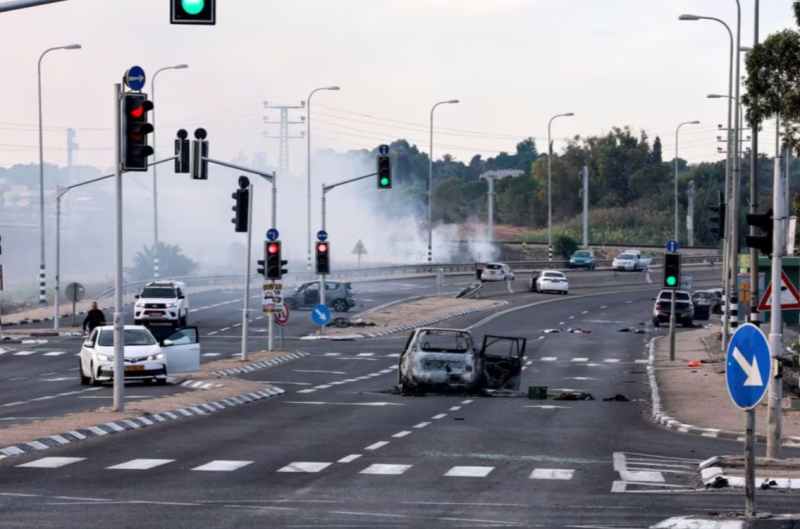
A view of a junction shows the aftermath of a mass-infiltration by Hamas gunmen from the Gaza Strip, in the Sderot area, southern Israel Oct. 7, 2023. (Credit: Ammar Awad/Reuters/File Photo)
A report published by the UN on Monday concluded that despite “limited survivor and witness testimony, limited forensic evidence” and “minimal crime scene processing, and the very limited forensic examination conducted," there are "reasonable grounds to believe that conflict-related sexual violence occurred during the Oct. 7 attacks."
The report was submitted to the UN Secretary-General and contains findings from the mission of a team led by UN Special Representative Pramila Patten and made up of a forensic pathologist, a digital and open-source information analyst and specialists trained in ethical interviewing of survivors and witnesses of sexual violence.
The report describes the significant challenges faced both by Israeli authorities following the Oct. 7 attack and by the UN's investigative team during its visit in early February. Among the challenges cited is the sheer number of victims and the wide range of locations where various devastating incidents of violence took place.
No first-hand testimony
The team's investigation was notably hindered by a lack of first-hand testimonies of sexual assault. According to the report, the team did not meet with any victims of sexual violence from Oct. 7. Apparently, the team was informed of a small number of survivors who are undergoing “specialized treatment,” and were unavailable for interviews.
During its visit, the team conducted 33 meetings with Israeli national institutions, including the Israeli Army, Shin Bet, and Israeli National Police. It also met with Israeli President Isaac Herzog and visited the morgue where bodies of victims were transferred as well as one visit to the Israeli National Center of Forensic Medicine.
The team conducted interviews with 34 individuals including released hostages, survivors and witnesses of the Oct. 7 attacks, first responders, and health and service providers. They also reviewed, the report says, 5,000 photos and around 50 hours of footage of the attacks, provided by “various state agencies,” independent private sources, and through “an independent online review” of open sources.
'Inadequately trained volunteer first responders'
The team visited four locations affected by the Oct. 7 attacks in the Gaza Envelope, including the Nova music festival site, the Be’eri kubbutz, Nahal Oz military base, and Road 232, where reports of sexual violence had emerged.
The report describes Israel’s investigations following Oct. 7 as having “faced numerous challenges.” Difficulty in coordination and information sharing between governmental agencies hindered Israel’s ability to collect evidence, the report claims, compounded by the large number of casualties and the wide dispersal of crime scenes. Several of the bodies recovered from the scenes of the attack were burned beyond the point at which sufficient evidence of sexual violence could be collected. The report also blamed “inadequately trained volunteer first responders,” and the prioritization of burials in accordance with religious practices over the collection of forensic evidence.
The result means both Israeli authorities and the investigating UN team were left with “limited survivor and witness testimony, limited forensic evidence” and “minimal crime scene processing and the very limited forensic examination conducted.”
An absence of “comprehensive forensic evidence” limited the investigation, and in several instances, the team was unable to come to any definitive forensic conclusions.
Patterns of sexual violence
Still, the report concludes that “based on the information gathered by the mission team from multiple and independent sources, there are reasonable grounds to believe that conflict-related sexual violence occurred during the Oct. 7 attacks … including rape and gang rape, in at least three locations.”
At the site of the Nova music festival, “credible sources described finding five murdered individuals, mostly women, whose bodies were naked from their waist down – and some totally naked – tied with their hands behind their backs, many of whom were shot in the head,” the report reads. “Although circumstantial, such a pattern of undressing and restraining victims may be indicative of some forms of sexual violence."
As for the reports of sexual violence from Be’eri and Kfar Aza, and the Nahal Oz military base, the team was unable to verify any of the reports of sexual violence. Only at Kfar Aza, was there evidence that could be indicative of “some form of sexual violence.”
However, the team did find “clear and convincing” information that some hostages have been subjected to sexual violence including rape and sexualized torture.
There are an estimated 101 hostages still alive and captive in Gaza.